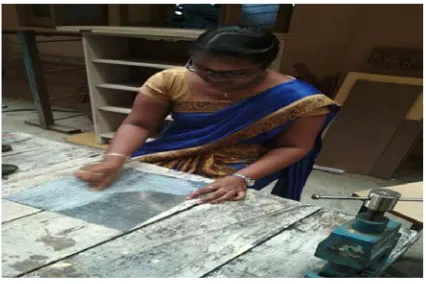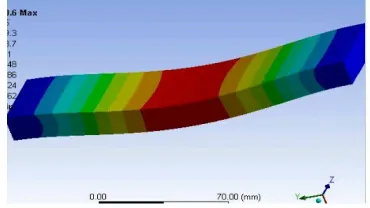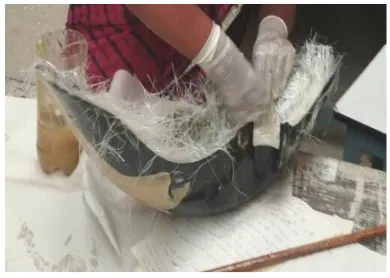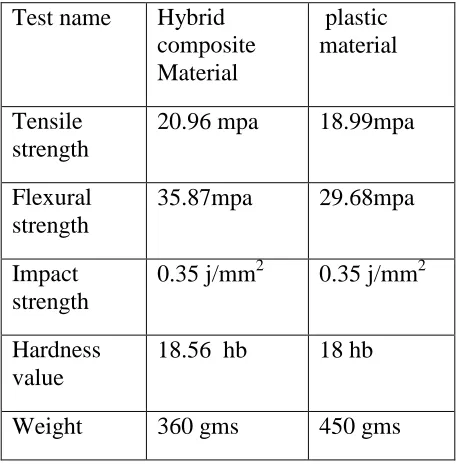147
Fabrication and Comparative Analysis of
Mechanical Properties of Reinforced Sisal
Fibre and Jute, Banana, Glass Fibre
Composite
Ayla RavalikaP
1
P
, Suresh NallaP
2
P
, Dr. E. SurendarP
3
P
1
P
Student, Warangal Institute of Technology & Science, Warangal-506342,
P
2
P
Assistant Professor, Warangal Institute of Technology & Science, Warangal-506342,
P
3
P
Associate Professor, Warangal Institute of Technology & Science, Warangal-506342,
ABSTRACT
The present work attends to make an improvement in the current existing sheet manufacturing methodology and materials used to have better mechanical properties as well as to enhance the compatibility between fiber and the matrix the bio composites are prepared with the unsaturated polyester matrix and fiber and comparative study has been made from eco friendly sisal fibre composite and jute, banana and glass fiber using hand layup method with appropriate proportion to result in sheet structure. The fabricated composites are planned to evaluate its mechanical properties such as tensile, impact, hardness and flexural strength and the results are compared in Ansys Software.
Keywords: Bio composite, Mechanical
strengths, Eco friendly, Banana, Jute, Glass fibre, Sisal fibre.
1. INTRODUCTION
This work investigates the hybridization of glass fibers with natural fibers for the applications of structural, aerospace and automobile industry. Composites made of
148
2. MATERIALS USED &
PREPERATION OF SPECIMENS
Materials used
A . Epoxy resin (LY-556)
B. Hardener(HY-951)
C. Natural Fibers (banana,jute,glass fibre)
2.1 Features of Epoxy
a. Light weight
b. Resists most alkalis and acids
c. Resists stress cracking
d. Retains stiffness and flexibility
e. Low moisture absorption f Non-staining
g. Easily fabricated
2.2 Advantages of Natural Fibers
Comparing to conventional reinforcing fibers like glass, carbon and Kevlar, natural fibers have the following advantages:
1 Environmentally friendly
2 Fully biodegradable
3 Non toxic
4 Easy to handle
5 Non abrasive during processing and use
6 Low density/light weight
7 Source of income for rural/agricultural community
8 Renewable, abundant and continuous supply of raw materials
9 Low cost
2.3. Preparation of Specimen:
1. The mould is first selected in order to give
shape and dimension to the product. The
mould chosen for this project was G I Sheet
of dimensions 150 X 150 mm is considered
2. The fiber cloths are cut into pieces which helps in fabrication process.
3. The mold is thoroughly coated with releasing agent. This releasing agent helps the component to get detached from the mould easily. Wax is used as a releasing agent for the manufacturing.
Fig 2.1. Applying Wax on the Mould
4. The mould which is coated with the wax is kept idle for almost 20 minutes. 5. Epoxy and hardener are mixed in the ratio of 2:1 and stirred it thoroughly. 6. First layer of epoxy resin is applied on the mould with the help of brush
Fig 2.2. Applying the Resin On To the Mould
149 Fig 2.3 Adding Layers of Sisal fiber
8. It is then kept for drying. A drier is used to make the process faster.
9. Another layer of Epoxy hardener mixture onto the first layer.
10. This process is continued till four layers of fibers are added on the mould.
11. One more layer of Epoxy hardener is added on the fourth layer to give a smooth finish to the Samples.
12.The samples are allowed of 12 hours to become harder.
13.When the layers becomes hard in the shape of the composite detach from the mould by gently heating the mould.
14. Similarly three samples were prepared with combination of sisal, banana, jute and glass fibers.
Fig 2.4. Samples removed from the Mould
3. RESULTS AND DISCUSSIONS
3.1 Impact test Results:
Fig 3.1 Impact test specimen
Table 3.1: impact test results
Number of layers Impact strength
Sample 1 0.35 J/mmP
2
Sample 2 0.21 J/mmP
2
Sample 3 0.21 J/mmP
2
3.2 Hardness test Results
150
Table 3.2: hardness test results
Number of layers Hardness number
Sample 1 18.6
Sample 2 14.25
Sample 3 17.7
3.3 Flexural Test Results
Fig 3.3 Flexural test specimen
Table 3.3: flexural stress result
Number of layers Load (N) Flexuial strength (N/mmP
2
P
)
Sample 1 180 37.64
Sample 2 120 35.87
Sample 3 60 11.7
3.4 Tensile Test Results
Fig 3.4 Tensile Test Specimens
Table 3.4.tensile test result
Number of layers
Width(mm* thick)
Ultimate tensile load (N)
Ultimate tensile strength (mpa) Sample
1
13.42*5.87 1380 20.96
Sample 2
13.36*3.85 1080 17.51
Sample 3
13.66*6.01 1080 13.15
3.4 Analysis model comparison
The experimental results are compared with ansys results, here ansys model is created for the composite material which has greater strength so only the composite material made of glass, banana, jute and sisal fiber i.e sample 1of 4 layers is compared with ansys.
3.4.1 Analysis Models
Fig 3.5 tensile stress.
151
Fig 3.7 :min principle elastic strain
Fig 3.8 : max shear elastic strain
3.5 Ansys Results:
Tensile strength and flexural strength for sample 1, which is of 4 layers are shown in below table
Table 3.5 Ansys Results
Type Tensile
test
Flexural strength
Maximum Principal Stress
Maximum 3.6e-0.04mpa
35mpa 29mpa
From the above comparison values Hybrid composite has the greater advantage and the results of samples and ansys are relatively equal.
From the above all test results, the sample 1 is having higher values of flexural strength and tensile strength along with higher hardness values and impact values. Based on the test results in the combination of sample 1 materials a component is manufactured which could be usable in automobiles.
4. PREPARATION OF BIKE
MUDGUARD
For preparing bike mudguard, plastic mudguard is taken as base and followed same procedure same as the specimen preparation. Initially a realizing agent was applied and then layers of epoxy and fibers were added and the final product is dried for 12 hours and the product is removed from the mould.
Fig 4.1 Applying Wax on the mould
152 Fig 4.3 Final mudguard prepared with hybrid
composite
The hybrid composite mudguard that has been produced is compared with the original plastic mudguard that has been used in bikes, the comparative values are shown in the table below.
Table 4.1: composite material and abs plastic results comparison
Test name Hybrid
composite Material
plastic material
Tensile strength
20.96 mpa 18.99mpa
Flexural strength
35.87mpa 29.68mpa
Impact strength
0.35 j/mmP
2
0.35 j/mmP
2
Hardness value
18.56 hb 18 hb
Weight 360 gms 450 gms
5. CONCLUSION
The Hybrid composite materials with different compositions had been
manufactured and tested, based up on the results, sample 1 comprises of Glass, Sisal, Banana and jute fibers had greater strength when compared with other samples, after analyzing the results of sample 1, bike mudguard had been produced with hybrid composite and again compared with plastic mudguard that is currently used in bikes, the results had shown Hybrid composite has greater impact, hardness, Tensile and Flexural strength. With this results the Hybrid composite materials can be used in automobiles with greater reduction in weight thus generates less pollution and also Biodegradable.
6. REFERENCES
1. Bledzki AK, Gassan J. Composites
reinforced with cellulose based
fibres. Prog Polym Sci 1999;24:221–
74.
2. Jochen Gassan. A study of fibre and
interface parameters acting the
fatigue behavior of natural fibre
composites. Composites Part A:
2002;33(3):369–74.
3. Anon. The competitiveness of
natural fibers based composites in
the automotive sector the Sisal
Agribusiness in Brazil.Mater Res
Soc Sym Proc 2002;702:113–39.
4. Van de Velde K, Kiekens P.
Thermoplastic pultrusion of natural
fibre reinforced composites. Comp
153 5. Iannace S, Ali R, Nicolais L.Effect
of processing conditions on
dimensions of sisal fibers in
thermoplastic biodegradable
composites. J Appl Polym Sci
2001;79(6):1084–91.
6. Wang wei, Huang Gu,
Characterization and utilization of
natural coconut fibers composites,
journal of Materials and




